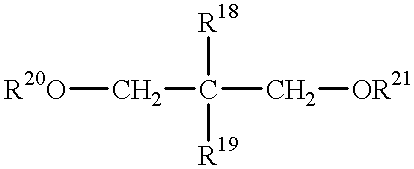Solid catalyst component for alpha-olefin polymerization, catalyst for alpha-olefin polymerization, and process for producing alpha-olefin polymer
a technology of alpha-olefin and solid catalyst, applied in the direction of catalyst activation/preparation, physical/chemical process catalyst, chemical/physical process, etc., can solve the problems of low activity, decrease the bulk density of the resulting polymer particles, and adverse effects on the stability and processability of poly-.alpha-olefin
- Summary
- Abstract
- Description
- Claims
- Application Information
AI Technical Summary
Benefits of technology
Problems solved by technology
Method used
Image
Examples
example 1
(a) Synthesis of reduced solid product
The atmosphere in a 500 ml flask with a stirrer and a dropping funnel was replaced with nitrogen, and 290 ml of hexane, 8.9 ml (8.9 g: 26.1 mmol) of tetrabutoxytitanium, 3.1 ml (3.3 g: 11.8 mmol) of diisobutyl phthalate, and 87.4 ml (81.6 g: 392 mmol) of tetraethoxysilane were mixed in the flask to obtain a homogeneous solution. While the temperature in the flask was kept at 6.degree. C., 199 ml of a dibutyl ether solution of butylmagnesium chloride (manufactured by Yukigosei Yakuhin K.K., concentration of butylmagnesium chloride: 2.1 mmol / ml) was added dropwise from the dropping funnel over 5 hours. After the dropwise addition, the solution was further stirred at 6.degree. C. for one hour and at room temperature for an additional one hour. The solution was subjected to solid-liquid separation and washed three times with 260 ml of toluene. An adequate amount of toluene was then added to the solid product thus obtained to form a slurry having the...
example 2
(c) Polymerization of propylene
Propylene was polymerized with the solid catalyst component prepared in the step (b) of Example 1 in the same manner as in the step (c) of Example 1, except that tert-butyl-n-propyldimethoxysilane was used in place of cyclohexylethyldimethoxysilane. Conditions and results of polymerization are shown in Table 1.
example 3
(b) Synthesis of solid catalyst component
After 22.5 ml of the supernatant was taken from 46 ml of the solid product-containing slurry prepared in the step (a) of Example 1, a mixture of 0.71 ml (5.73 mmol) of butyl ether and 11.4 ml (0.104 mol) of titanium tetrachloride and subsequently 1.42 ml (9.86 mmol: 0.20 ml / 1 g of solid product) of phthaloyl chloride were added to the slurry. The slurry was heated to 115.degree. C. and stirred for three hours. After completion of the reaction, the slurry was subjected to solid-liquid separation and washed twice with 36 ml of toluene at the same temperature. A mixture of 9.0 ml of toluene, 0.40 ml (1.49 mmol) of diisobutyl phthalate, 0.71 ml (5.73 mmol) of butyl ether, and 5.7 ml (0.052 mole) of titanium tetrachloride was added to the product for one-hour treatment at 115.degree. C. after completion of the reaction, the product was subjected to solid-liquid separation at the same temperature, washed three times with 36 ml of toluene and anothe...
PUM
| Property | Measurement | Unit |
|---|---|---|
| temperature | aaaaa | aaaaa |
| temperature | aaaaa | aaaaa |
| temperature | aaaaa | aaaaa |
Abstract
Description
Claims
Application Information
 Login to View More
Login to View More - R&D
- Intellectual Property
- Life Sciences
- Materials
- Tech Scout
- Unparalleled Data Quality
- Higher Quality Content
- 60% Fewer Hallucinations
Browse by: Latest US Patents, China's latest patents, Technical Efficacy Thesaurus, Application Domain, Technology Topic, Popular Technical Reports.
© 2025 PatSnap. All rights reserved.Legal|Privacy policy|Modern Slavery Act Transparency Statement|Sitemap|About US| Contact US: help@patsnap.com

